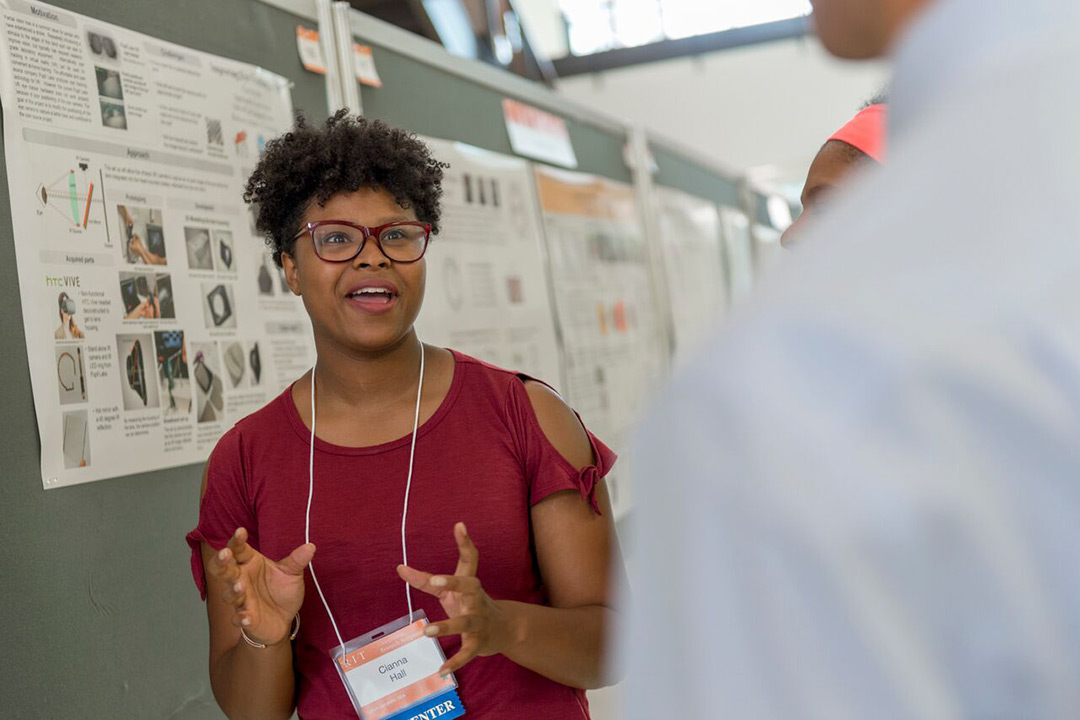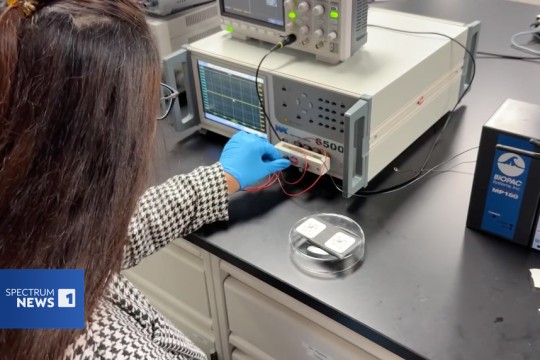Undergraduate student innovators unveil research at 27th annual symposium
Event solidifies university’s engagement in high-impact student-centered research
Elizabeth Lamark
Cianna Dresden Hall, a fourth-year biotechnology and molecular bioscience major from Rochester, N.Y., explains her research on The Catheter Solution.
Samuel Lum lost a loved one to a serious infection that stemmed from a catheter. The loss encouraged him to gather together a student research team dedicated to developing an enzyme that would prevent bacteria growth inside the medical devices. His project, “The Catheter Solution,” was among more than 250 student projects, representing all nine colleges, on display at the 27th annual Undergraduate Research Symposium on Aug. 3 at RIT. Research proposals were featured in a series of oral and poster presentations throughout the day.
The event, which took place in Louise M. Slaughter Hall and Sustainability Institute Hall, is structured as a professional research conference. Some of the research themes included biomedical and life sciences; optics, photonics and imaging; energy and sustainability; business; chemistry and materials sciences and engineering; computer modeling, design and simulation; ecology; and social sciences and humanities.
"This event represents the culmination of hard work and thoughtful discussions with their research advisors," said Michael Coleman, associate professor of chemistry and symposium chairperson. "It is a unique opportunity for these aspiring scientists to present their research interests to the diverse and supportive RIT scientific community."
Joshua Faber, associate professor of mathematical sciences in RIT’s College of Science, sees his role as a research adviser as steering his undergraduate students toward research where they can use their existing skills, teaching them new things that will aid them as they develop as scientists, and trying to broaden their horizons as to what science is and how they can make continuing contributions to it.
“The undergraduates who are here over the summer are often tremendously motivated and very hard-working, and really push their advisers to keep giving them more and more responsibilities,” said Faber. “Science research tends to be a small-scale endeavor, with even the largest research groups consisting of a few students, a postdoc or two, and one or two faculty advisers. In these circumstances, undergrads are typically the junior people in the effort, surrounded by people they perceive to be experts. At the symposium, it is a perfect chance to reach a broader audience and demonstrate their rapidly growing expertise to a more diverse group of their peers and possible future colleagues. As a scientist, it is critical to find one’s voice to communicate the work to both the field and the broader public, and the symposium is a great first step in this process.”
This year’s presentations featured a gamut of far-reaching innovations—from researching supermassive black holes, to the impact of wetlands on greenhouse gases, to the effects of leaderships styles on motivation.
Lum, a fifth-year mechanical engineering technology major/cellular biology minor from New York, N.Y., said that leading his research group as an undergraduate student is the biggest undertaking of his life so far. He is proud of his team that has worked tirelessly throughout the summer, and he’s excited to be able to continue what they’ve started. Lum plans to be a visiting scholar at Johns Hopkins University next semester.
“Anyone who spends time in an intensive care unit understands that there is a high risk of infection,” he said. “But a death caused by infection shouldn’t just be classified as a natural cause of death. We know that we have the power to do something about it and can make an impact on society.”
Other student projects included:
- Ryan Pluck, a fourth-year psychology student in the College of Liberal Arts, is studying visual perception in animals and how North American river otters process shapes above and below water. For the past few months, he has been part of the Summer Undergraduate Research Fellowship program. His grant-funded work with otters Heather and Sailor from Rochester’s Seneca Park Zoo will ultimately help determine how they identify food and predators and will enhance otter conservation efforts and the understanding of otter ecosystems.
“These otters are very cute, and they were extra cute when I saw them this morning,” said Pluck, who is from North Wales, Pa. “I started out as a software engineering major, but I knew that it wasn’t the right fit for me. I took my adviser’s suggestion to study animal behaviors and cognitive psychology, which were also interests of mine. In the future, I hope to attend graduate school studying in this field. I’ve spent a lot of time with these otters and I love seeing them succeed. If I told my high school self that I would be working with otters three days week, I would have never believed it.”
- As part of their Saunders College of Business poster submission, Yu Lu and Yulin Bian, Chinese students majoring in marketing from Beijing Jiaotong University, researched the use of virtual reality at Rochester Red Wings games.
“In our conversations with the Red Wings organization, we were told that they are hoping to expand their audience to attract more 18- to 30-year-old spectators,” said Bian. “We believe that by implementing cutting-edge technology such as virtual reality into the Red Wings experience, viewers will be able to watch games from multiple stadium viewpoints while also learning about the players. From a business and marketing perspective, this makes a lot of sense to us.”
The keynote speaker for the symposium was Stephen Polly ’09 ’15 (microelectronic engineering, microsystems engineering), a research scientist in RIT’s NanoPower Research Laboratory.
The symposium is sponsored by RIT’s Office of the Vice President for Research.
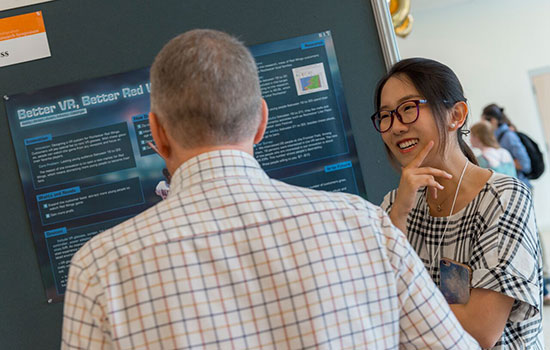 Yulin Bian, a Chinese student majoring in marketing from Beijing Jiaotong University, studied how using technology like virtual reality could change the demographics at Rochester Red Wings games. Elizabeth Lamark
Yulin Bian, a Chinese student majoring in marketing from Beijing Jiaotong University, studied how using technology like virtual reality could change the demographics at Rochester Red Wings games. Elizabeth Lamark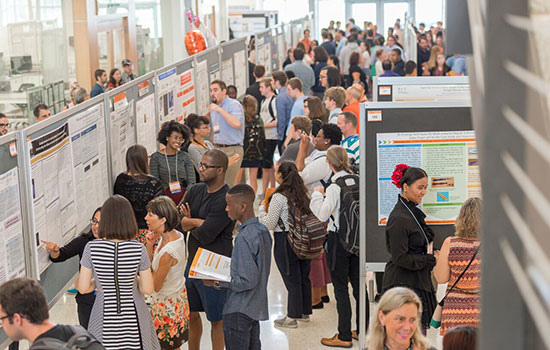 More than 250 undergraduate student research projects were on display in Sustainability Institute Hall with a series of oral presentations held in Louise M. Slaughter Hall. Elizabeth Lamark
More than 250 undergraduate student research projects were on display in Sustainability Institute Hall with a series of oral presentations held in Louise M. Slaughter Hall. Elizabeth Lamark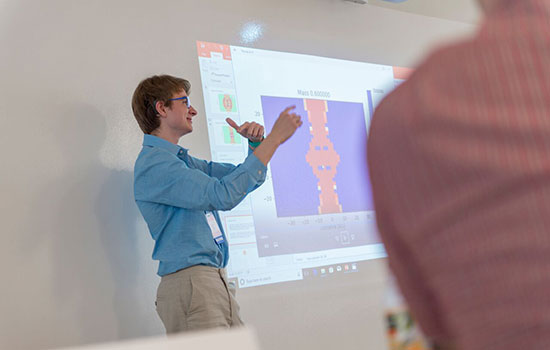 Jeremy Wilson, a physics major from Skidmore College studying at RIT as part of the summer Research Experience for Undergraduates (REU), delivers his oral presentation on 'Lost Planets and Dying Stars: Simulations of Post-Main Sequence Systems.' Elizabeth Lamark
Jeremy Wilson, a physics major from Skidmore College studying at RIT as part of the summer Research Experience for Undergraduates (REU), delivers his oral presentation on 'Lost Planets and Dying Stars: Simulations of Post-Main Sequence Systems.' Elizabeth Lamark








